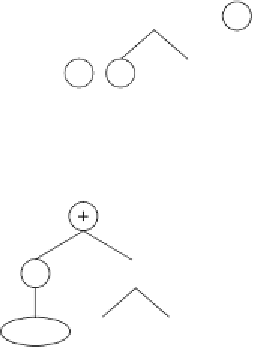Information Technology Reference
In-Depth Information
Consider, for instance, the following chromosome:
012345601012345601012345601
01234560123
/+a/abbba+*-abbabb/b*+abaab
+Q/0*210212
(2.17)
It codes for three conventional genes and one homeotic gene (shown in bold).
The three conventional genes code, as usual, for three different sub-ETs, with
the difference that now these sub-ETs may be invoked multiple times from
different places, or, stated differently, they will act as automatically defined
functions (ADFs). And the homeotic gene controls the interactions between
the different sub-ETs or, in other words, determines which functions are used
to link the sub-ETs or ADFs and how the linking is established (Figure 2.7).
a.
012345601012345601012345601
/+a/abbba+*-abbabb/b*+abaab
01234560123
+Q/0*210212
b.
ADF
0
ADF
1
ADF
2
/
a
b
a
a
a
/
a
b
b
a
b
b
b
c.
Cell
Q
/
ADF
0
ADF
2
ADF
1
ADF
0
Figure 2.7.
Expression of chromosomes with a single homeotic gene encoding a
main program or cell.
a)
The chromosome composed of three conventional genes
and one homeotic gene (shown in bold).
b)
The sub-ETs or ADFs codified by each
conventional gene.
c)
The final main program or cell. Note that the cellular system
allows code reuse as each ADF might be called several times by the main program.











